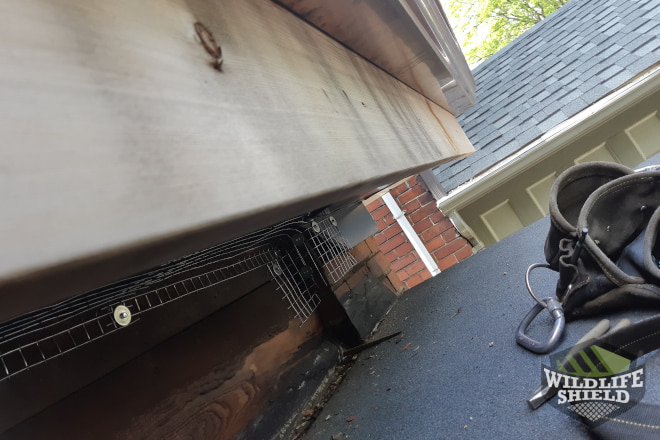The following case study details a squirrel removal job in Toronto, Ontario. A squirrel that was nesting in the roof between the first and second storeys of this single-family home was removed humanely, using a one-way door. To ensure that the animal would not come back, the technician on duty excluded the rest of the roof. For squirrel removal you can count on, give Squirrel Control a call. We provide safe and effective squirrel removal services throughout the GTA.
Inspection
The homeowner in this case first gave Squirrel Control a call when he heard an animal moving around in the attic. It was May, and the animal was making a lot of scratching noises during the day. A technician came the next day to investigate. With every situation, our technicians inspect first. This determines where the squirrels are nesting and all other vulnerabilities that could lead to a future invasion.
Here, the technician found the squirrel’ entry point along the edge of the roof between the first and second floors of the home. The squirrel in this situation had probably climbed up into the eavestrough, then chewed it way through the edge of the roof, at the drip line. This is a common entry point for squirrels.
Continuing on with the inspection, the technician found about 10 feet of gaps along the side of the home, between the entrance of the home and the roofing above. There were gaps wide enough to fit a squirrel. If these were not sealed along with the entrance to the squirrel’s nest, the squirrel risked coming right back. Squirrels frequently come back to their nesting locations after they have been evicted.

To remove the animal, the technician recommended installing a one-way door to its entry point. This would force the squirrel out of its den because the door would shut behind it. As for the gaps along the edges of the roof, the technician offered to close them off with mesh. The homeowner agreed to get the work done, and the technician got started.
Removal and Exclusion
First, the technician installed the one-way door. This contraption is much like an open-ended trap. It is made of mesh, like conventional traps, but open at one end to let the animal out. So, when the squirrel wants to leave its den, it simply pushes its way through the door. Once out, it cannot get back in.

Next, the technician put 10 feet of mesh along the edge of the roof. The mesh used was a 16-gauge, galvanized steel mesh, with gaps half an inch wide. This is a weather-proof material that is tough enough to keep squirrels and raccoons out. It won’t rust, and it will keep animals out of the attic.

Conclusion
Within a few weeks, the squirrel was gone, and a technician returned to remove the door and replace it with mesh. This case demonstrates how straightforward it is to remove squirrels professionally. Our technicians have a good eye for detail and know where to find entry points.

If you are worried about the squirrels in your area, give us a call. A technician will inspect your property for vulnerabilities and exclude them for you. We are so sure of our services that they come with a 2-year warranty. Call us today if you have any questions.